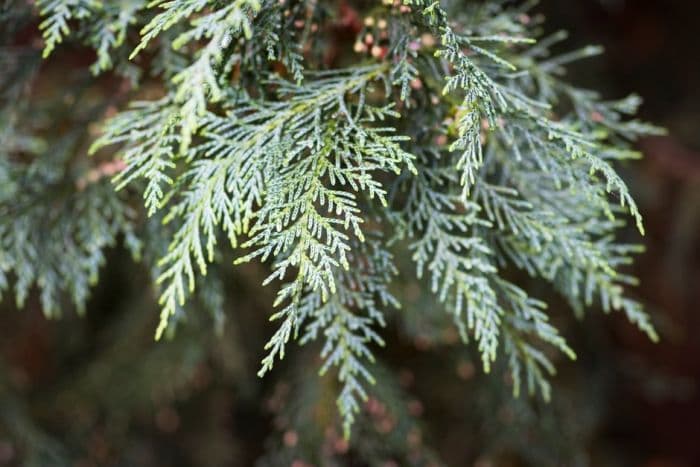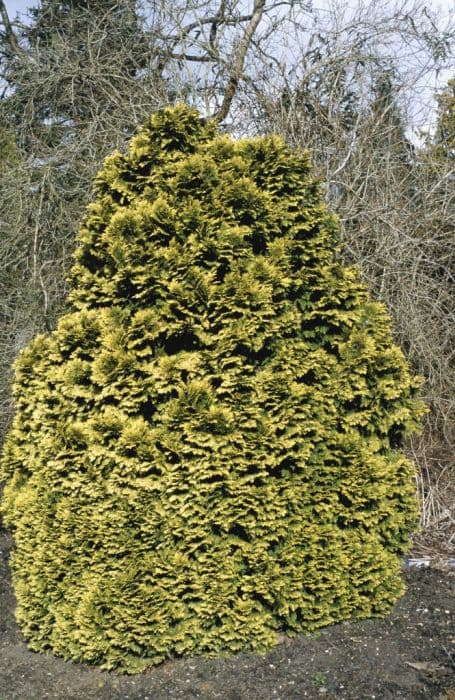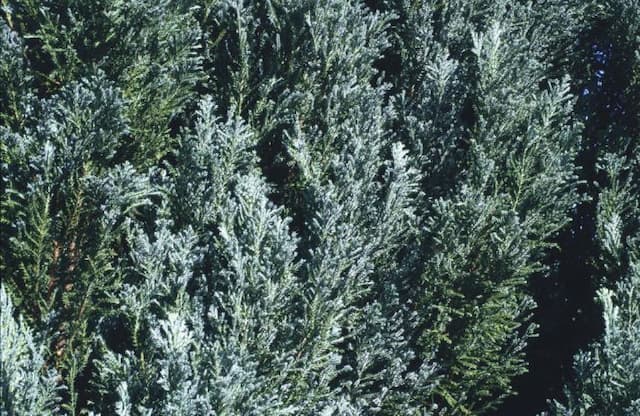Leyland Cypress × Cuprocyparis leylandii 'Naylor's Blue'

ABOUT
The Leyland cypress 'Naylor's Blue' is an evergreen conifer with a distinct appearance. It boasts dense, feathery foliage with a unique steel-blue color that can add a calming presence in various landscapes. The needles are relatively short, soft to the touch, and grow in a somewhat flattened, spray-like pattern. The conifer's overall shape tends to be pyramidal with a strong central leader, making it a popular choice as a specimen or for creating privacy hedges due to its dense growth habit. The branches ascend from the trunk at a tight angle with lots of fine, scale-like leaves that cover the twigs thickly, giving the tree a full-bodied look. The tree's bark is typically dark and may develop a textured, ridged pattern as it matures. Its non-showy, small brown cones may go largely unnoticed, hidden amidst the thick foliage. The visual appeal of 'Naylor's Blue' stems from its distinctive color and lush texture rather than from any floral display, making it a sought-after choice for gardeners seeking year-round color and structure.
About this plant
 Names
NamesFamily
Cupressaceae.
Synonyms
Leyland Cypress, Naylor's Blue.
Common names
× Cupressocyparis leylandii 'Naylor's Blue', Cupressus × leylandii 'Naylor's Blue', Callitropsis × leylandii 'Naylor's Blue', Hesperotropsis leylandii 'Naylor's Blue', Neocupressus × leylandii 'Naylor's Blue'.
 Toxicity
ToxicityTo humans
Leyland cypress is not considered toxic to humans. However, like many plants, it can cause contact dermatitis in some people with sensitive skin. Ingesting parts of this plant is not known to cause serious poisoning or significant symptoms in humans.
To pets
Leyland cypress is not commonly listed as a toxic plant to pets. While it's not considered highly toxic, ingestion of large quantities of plant material might cause mild stomach upset in some animals. However, serious poisoning and significant symptoms are not generally associated with this plant.
 Characteristics
CharacteristicsLife cycle
Perennials
Foliage type
Evergreen
Color of leaves
Blue-green
Height
60 feet (18 meters)
Spread
15 feet (4.5 meters)
Plant type
Tree
Hardiness zones
6
Native area
Hybrid
Benefits
 General Benefits
General Benefits- Fast Growth: Leyland Cypress is known for its rapid growth rate, making it a popular choice for a quick privacy screen or windbreak.
- Privacy: With its dense foliage, it provides an excellent visual barrier for privacy.
- Noise Reduction: The thick evergreen foliage helps to absorb sound, making it a good option for noise reduction along busy roads or noisy neighborhoods.
- Low Maintenance: Once established, Leyland Cypress requires minimal care, aside from occasional pruning to maintain the desired shape.
- Wind Protection: Its strong structure and dense growth habit make it effective at providing wind protection for buildings and other plants.
- Erosion Control: The plant's root system helps to stabilize soil and prevent erosion on slopes and embankments.
- Wildlife Habitat: It offers shelter and nesting sites for various species of birds and other wildlife.
- Aesthetic Appeal: 'Naylor's Blue' has attractive bluish-green foliage that can enhance the visual appeal of landscapes.
 Medical Properties
Medical PropertiesThis plant is not used for medical purposes.
 Air-purifying Qualities
Air-purifying QualitiesThis plant is not specifically known for air purifying qualities.
 Other Uses
Other Uses- Windbreak or privacy screen – Leyland cypress like 'Naylor's Blue' are often planted in rows to create a fast-growing windbreak or natural privacy barrier due to their dense foliage.
- Noise reduction – The dense growth of a mature Leyland cypress hedge can help to dampen traffic noise when planted along roads or property lines.
- Erosion control – Their root systems can help stabilize soil on slopes and prevent erosion, making them beneficial in landscape areas prone to losing soil.
- Topiary or formal garden design – Leyland cypress can be shaped into various topiary forms for formal garden layouts or as focal points in landscapes.
- Shade for underplanting – The shade provided by a Leyland cypress can create a microclimate suitable for shade-loving plants to be grown underneath or nearby.
- Seasonal decor – Branches of Leyland cypress may be used in wreaths and garlands during the holiday season as a decoration.
- Wildlife habitat – The dense branches can provide nesting sites for birds and shelter for other small animals.
- Sound barrier for outdoor living spaces – Planting Leyland cypress around patios or outdoor entertainment areas can help create a quieter, more secluded environment.
- Backdrops for photography or art – Their uniform appearance and bluish-green foliage can serve as a natural backdrop for outdoor photography or plein air painting.
- Thematic gardens – Leyland cypress can be incorporated into thematic gardens, such as historic or literary-inspired gardens, where their size and form can replicate the look of an old estate or manor.
Interesting Facts
 Feng Shui
Feng ShuiLeyland Cypress is not used in Feng Shui practice.
 Zodiac Sign Compitability
Zodiac Sign CompitabilityLeyland Cypress is not used in astrology practice.
 Plant Symbolism
Plant Symbolism- Growth: Leyland Cypress, known for its rapid growth rate, symbolizes continual and fast-paced growth in various aspects of life.
- Protection: Due to its dense foliage, the Leyland Cypress is often used for privacy hedges, symbolizing shelter and a protective barrier.
- Longevity: As an evergreen plant, it represents eternal life and enduring presence through all seasons.
- Resilience: It can adapt to various soil conditions and environments, which symbolizes adaptability and the ability to overcome challenges.
 Water
WaterLeyland Cypress 'Naylor's Blue' should be watered deeply every few days to once a week, depending on the weather and soil moisture levels. During its first growing season, it's essential to maintain a consistent watering schedule to establish a strong root system. After the tree is established, it will need less frequent watering. Water the plant with about 1-2 gallons for younger trees and up to 5 gallons for mature trees each time you water. Ensure the water penetrates deeply into the soil, reaching the root zone without causing waterlogging.
 Light
LightLeyland Cypress 'Naylor's Blue' thrives best in full sun, which means at least six hours of direct, unfiltered sunlight a day. The ideal location is an open area without significant shade from other trees or structures. Adequate sunlight ensures the healthiest growth and dense foliage for this evergreen.
 Temperature
TemperatureLeyland Cypress 'Naylor's Blue' is hardy and can tolerate a wide range of temperatures, typically from about 20 degrees to 100 degrees Fahrenheit. However, the ideal temperature range for this plant to thrive is between 50 and 80 degrees Fahrenheit. Protecting it from extreme cold and frost is important for its health and longevity.
 Pruning
PruningPrune Leyland Cypress 'Naylor's Blue' to shape it or control its size, typically once a year in late winter or early spring before new growth begins. Pruning can also help prevent disease by increasing air circulation within the foliage. For substantial pruning, avoid cutting back more than one-third of the tree's height or width in a single season.
 Cleaning
CleaningAs needed
 Soil
SoilLeyland Cypress 'Naylor's Blue' thrives in moist, well-drained soil with a mix of sand, loam, and clay. It prefers a slightly acidic to neutral pH, ranging from 6.0 to 8.0.
 Repotting
RepottingLeyland Cypress 'Naylor's Blue' is typically grown in the landscape and does not require repotting. In pots, young trees may be repotted every few years.
 Humidity & Misting
Humidity & MistingLeyland Cypress 'Naylor's Blue' is adaptable to a wide range of humidity levels and does well in average outdoor humidity.
 Suitable locations
Suitable locationsIndoor
Not ideal indoors; requires ample light & space.
Outdoor
Plant in sun, shelter from wind, ensure soil drainage.
Hardiness zone
6-10 USDA
 Life cycle
Life cycleLeyland Cypress 'Naylor's Blue' begins its life as a seed that germinates in moist soil conditions during spring. The seedling stage follows, where it establishes a root system and begins to grow its first leaves, taking several years to develop into a young tree. As a juvenile, the plant experiences rapid vertical growth, with the distinctive blue-green foliage becoming more pronounced. Maturing into an adult tree, 'Naylor's Blue' reaches its full height and starts to reproduce, forming cones that contain the seeds, usually when the tree is several years old. The reproductive stage lasts for many years, during which the tree produces numerous seeds annually. Finally, as the tree ages and reaches the end of its lifespan, which can be several decades under ideal conditions, growth slows down and it eventually succumbs to environmental stressors, disease, or old age.
 Propogation
PropogationPropogation time
Spring-Early Summer
Leyland cypress 'Naylor's Blue', commonly known as Leyland cypress, can be propagated through semi-hardwood cuttings usually taken in late summer to early fall, although timing can vary depending on your local climate conditions. The most popular propagation method is to select healthy, disease-free branches from the parent plant and cut 4-6 inch (10-15 cm) long cuttings with several sets of leaves. The lower set of leaves should be removed, and the base of the cutting should be dipped in a root hormone powder to encourage root development. The prepared cuttings are then inserted into a well-draining growing medium, such as a mix of peat and perlite, ensuring at least two nodes are buried where leaves were removed. The cutting tray should be kept moist and in a warm environment with indirect sunlight until roots develop, which typically takes several weeks. Once rooted, the new Leyland cypress plants can be transplanted into individual pots or directly outdoors in suitable growing areas.









